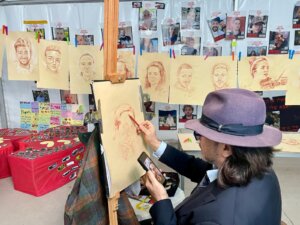“The Jumbotron at Tel Aviv’s Hostage Square keeps track of how long hostages have been in captivity. Every day, every hour that goes by, some here said on Feb 6, 2024, makes them more furious. Photo by Susan Greene
TEL AVIV — The only things that seem to change in Hostage Square are the numbers on the Jumbotron tracking the time since Hamas attacked Israel on Oct. 7. When I arrived Tuesday evening the electronic display showed 122 days, 11 hours, 14 minutes and one second.
I’d hurried over to the square as the sun fell after news broke that Israeli intelligence had confirmed that a fifth of the 136 people believed to still be in captivity in the Gaza Strip were dead. The New York Times’ article said the Israel Defense Forces had notified the families of those 32 hostages that they were no longer alive.
But the regulars keeping vigil here seemed unmoved by the news — and by stories that have been circulating for days suggesting that U.S.-brokered negotiations to pause the fighting and free the remaining hostages are progressing.
“This place, it’s like Groundhog Day,” said Ron Gross, a money manager who came to the square after leaving work in a nearby office tower. “Same thing day in and day out, with no substantive change”
Until the hostages are home, dead or alive, Gross and others I interviewed here today said, they’re not ready to mourn them, and not ready to celebrate, either.
Motti Gerlic is an immunology researcher who grew up on Kibbutz Nahal Oz, where at least 12 residents were killed and others abducted by Hamas on Oct. 7. Though Gerlic moved away from the kibbutz years ago, he came to sit today in the tent the community erected here to keep all its victims in the national and international conscience.
He pointed to a poster of hostage Tashi Ifwho Gerlic grew up with and said he loves like a brother.

“Tsachi, his family and all of these people were betrayed by our country that failed to keep them safe in their homes and keeps failing to bring them back from Gaza,” Gerlic told me. “We don’t have time. Every day, every hour that goes by without a deal is a betrayal.
“Yes, there is a price to release them. We need to pay the price now, and we’ll deal with Hamas later.”
Those comments reflected the findings of a new poll by the Israel Democracy Institutein which 51% of Israelis said the main goal of the ongoing war should be the return of the hostages, versus 36% who said it should be toppling Hamas. (Jewish Israelis are more evenly divided, with 47% prioritizing hostages and 42% toppling Hamas, while 69% of Arab citizens picked hostages and only 8% Hamas.)
The Hostage Families Forum did not respond to calls on Tuesday evening about which hostages were among the 32 confirmed dead. This number is higher than prior estimates released by Israeli officials. The Times article quoted an Israeli military spokesperson saying most of the 32 were believed to have been killed on Oct. 7; it was unclear how many of them were individuals whose deaths had previously been publicly announced.
A spokesperson for the family of Hersh Goldberg-Polin, the 23-year-old American-Israeli whose left arm was blown off by a grenade before he was taken to Gaza, said Tuesday that there had been “no updates” regarding his situation.
Gerlic, the former Nahal Oz resident, also said he had not been informed of any new information regarding his friend, Idan, who is 49 and was taken captive after terrorists shot and killed the oldest of his three children, 18-year-old Maayan, through their safe room door, according to The Times of Israel.
Gerlic himself recently returned from two months of reserve duty inside Gaza. If Idan were dead by now, he said in a hushed tone, he wouldn’t be surprised. “Nothing, believe me, nothing now would surprise me,” he said.

At Hostage Square, which sprung up outside the Tel Aviv Art Museum in the early days after the attack and has been home to protests most Saturday nights since, wear is beginning to show on the long, empty white Shabbat table symbolically set for the hostages four months ago. Its blue tablecloth has faded in months of sunshine and some of its 200-plus plastic wine glasses are partly full after 15 consecutive days of rain that ended Monday.
Israeli Scout troops and a woman’s book club toured the various artistic tributes to the missing Tuesday evening, while a German-speaking guide gave a group of Austrian visitors some background on the history of the Gaza Strip.
Albert Xhelili, an Albanian artist who has hand-drawn pencil portraits of dozens of hostages, sat at his easel working on the face of another. Creating art, Xhelili told me, is his way of channeling his fury over Oct. 7, and a way to “keep the hostages alive.” Even he added, if fewer of them are still alive, as today’s headlines suggested.
“I am so angry I don’t know what to do with myself,” he said of checking the news each day hoping for, but not seeing any, resolution to the hostage crisis. “If only there were something I could do besides draw.”
Albanian artist Albert Xhelili is at Hostage Square this week in Tel Aviv drawing pencil portraits of hostages. He sees his artwork as a way to keep them alive. (📹 @Greeneindenver @jdforward) pic.twitter.com/lkae9zZ7cr
— Benyamin Cohen (@benyamincohen) February 6, 2024











